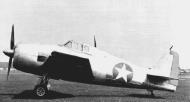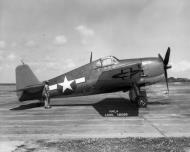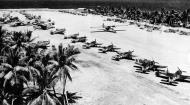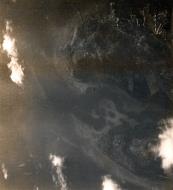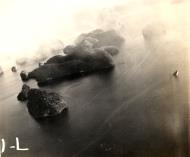The Grumman F6F Hellcat was a fighter aircraft descended from the earlier F4F Wildcat, but was a completely new design sharing only a familial resemblance to the Wildcat. Some tagged it as 'Wildcat's big brother'. The Hellcat and the Vought F4U Corsair were the primary United States Navy carrier fighters in the second half of World War II.
The Hellcat proved to be the most successful aircraft in naval history, destroying 5,171 aircraft while in service with the U.S. Navy and U.S. Marine Corps (5,163 in the Pacific and eight more during the invasion of Southern France), plus 52 with the Royal Navy's Fleet Air Arm during World War II. Postwar, the Hellcat aircraft was rapidly phased out of front line service, finally retiring in 1954 as a night-fighter in composite squadrons.
Design and development
Grumman was working on a successor to the F4F Wildcat well before the Japanese attacked Pearl Harbor. While the F4F was a capable fighter, early air battles revealed the Japanese A6M Zero was more maneuverable and possessed a better rate of climb than the F4F. The F4F did have some advantages over the Zero. Wildcats were able to absorb a tremendous amount of damage compared to the Zero, and had better armament. The F4F was also much faster in a dive than the Zero, an advantage Wildcat pilots used frequently to elude attacking Zeros.
These advantages carried over into the F6F and, combined with other improvements, created a fighter that outclassed the Zero almost completely. The contract for the prototype XF6F-1 was signed on 30 June 1941. The F6F was originally to be given the Wright R-2600 Cyclone engine of 1,700 hp (1,268 kW), but based on combat experience of F4F Wildcat and Zero encounters, Grumman decided to further improve their new fighter to overcome the Mitsubishi Zero's dominance in the Pacific theater. Grumman installed the Pratt & Whitney R-2800 Double Wasp 2,000 hp (1,500 kW) estimating a 25% increase in performance would result. The first, Cyclone-equipped prototype (02981) flew on 26 June 1942 while the first Double Wasp-equipped aircraft, the XF6F-3 (02982) had its first flight on 30 July 1942.
Proposed at the same time as the first Hellcat prototypes, the XF6F-2 incorporated a turbo-supercharger but performance gains were only slight and until fleet demands for improvements in speed, this variant, along with the two-speed supercharger-equipped XF6F-3, languished. However, later F6F-4 and F6F-5 variants did benefit from these initial development programs.
Like the Wildcat, the Hellcat was designed for ease of manufacture and ability to withstand significant damage. A total of 212 lb (96 kg) of cockpit armor was fitted to aid pilot survival, as well as a bullet-resistant windshield and armor around the engine oil tank and oil cooler. Self-sealing fuel tanks further reduced susceptibility to fire and often allowed damaged aircraft to return home. The U.S. Navy's all-time leading ace, Captain David McCampbell USN (retired) scored all his victories in the Hellcat. He once described the F6F as '...an outstanding fighter plane. It performed well, was easy to fly and was a stable gun platform. But what I really remember most was that it was rugged and easy to maintain.'
The first production aircraft off the line, designated F6F-3s, flew on 3 October 1942 with the type reaching operational readiness with VF-9 on USS Essex in February 1943.
Two night fighter subvariants of the F6F-3 were also developed. The F6F-3E, converted from standard -3 frames, featured the AN/APS-4 radar in a fairing in the starboard wing. The later F6F-3N, first seen in July of 1943, was fitted with the AN/APS-6 radar in a similar fairing. By November of 1943, Hellcat night fighters had seen their first action. Fitting AN/APS-6 radar fairings to F6F-5s resulted in the night fighter F6F-5N, and a small number of standard F6F-5s were also fitted with camera equipment for reconnaissance duties as the F6F-5P.
Instead of the Wildcat's narrow-track undercarriage retracting into the fuselage requiring awkward hand-cranking by the pilot, the Hellcat had hydraulically-actuated undercarriage struts set wider and retracting backward, twisting through 90° into the wings, exactly as the Chance Vought F4U Corsair's landing gear did. The wing was low-mounted instead of mid-mounted and folded the same way as the later versions of the Wildcat, allowing the Hellcat to take on a compact, tucked-in appearance on a flight deck.
Standard armament on the F6F consisted of six .50 caliber (12.7mm) Browning M2/AN air-cooled machine guns with 400 rounds each; later aircraft gained three hardpoints to carry a total bombload in excess of 2,000 lbs. (900 kg). The center hardpoint also had the ability to carry a single 150 U.S. gallon (568 L) disposable drop tank. Six 5 in. (127 mm) HVARs (High Velocity Aircraft Rocket) could be carried; three under each wing.
The next and most common variant, the F6F-5, featured improvements such as a more powerful R-2800-10W engine housed in a slightly more streamlined engine cowling, spring-loaded control tabs on the ailerons, deletion of the rear-view windows behind the main canopy, an improved, clear view windscreen with a flat armored-glass front panel replacing the curved perspex panel and internal armor glass screen and numerous other minor advances. Another improvement in the F6F-5 was the availability of more potent armament than the standard six .50 caliber (12.7 mm) machine guns. Trials with cannon-armed Hellcats were not followed up by a production version; although all F6F-5s could carry an armament mix of a pair of Hispano 20mm (0.79 in.) cannon cannon, one mounted in each of the inboard gunbays, with a minimum of 220 rounds per gun, along with two pairs of .50 caliber (12.7 mm) machine guns, with 400 rounds per gun, this configuration was only used on many later F6F-5N night fighters.
Two F6F-5s were fitted with the 18-cylinder 2,100 hp (1,567 kW) Pratt and Whitney R-2800-18W two-stage blower radial engine which was also used by the F4U-4 Corsair. The new Hellcat variant was fitted with a four-bladed propeller and was called the XF6F-6. The aircraft proved to be the best performer in the series with a top speed of 417 mph. Plans for mass production of this variant were cancelled with the advent of VJ day.
The last Hellcat rolled out in November 1945, the total production figure being 12,275, of which 11,000 had been built in just two years. This impressive production rate was credited to the sound original design, which required little modification once production was underway.
Operational history
Photo USS Yorktown (CV-10) during the Marcus Island raid on 31 August 1943: CAG-5 Lt. Cmdr. 'Jimmy' Flatley
The Hellcat first saw action against the Japanese on 1 September 1943 when fighters off the USS Independence (CVL-22) shot down a Kawanishi H8K 'Emily' flying boat. Soon after, on 23rd and 24th November, Hellcats engaged Japanese aircraft over Tarawa, shooting down a claimed 30 Mitsubishi Zeros for the loss of one F6F. Over Rabaul, New Britain, on 11 November 1943, Hellcats and Corsairs were engaged in day-long fights with many Japanese aircraft including A6M Zeros, shooting down nearly 50 airplanes. Hellcats also utilized the 'Thach Weave', which had been developed into a formation tactic to compensate for the older F4F Wildcat's deficiencies.
Hellcats were involved in practically all engagements with Japanese air power from that point onward. It was the major U.S. Navy fighter type involved in the Battle of the Philippine Sea, where so many Japanese aircraft were shot down that Navy aircrews nicknamed the battle The Great Marianas Turkey Shoot. The F6F accounted for 75% of all aerial victories recorded by the U.S. Navy in the Pacific. Radar-equipped Hellcat night fighter squadrons appeared in early 1944.
Navy and Marine F6Fs flew 66,530 combat sorties (45% of all fighter sorties of the war, 62,386 sorties were flown from aircraft carriers) and destroyed 5,163 (56% of all Naval/Marine air victories of the war) at a cost of 270 Hellcats (an overall kill-to-loss ratio of 19:1). The aircraft performed well against the best Japanese opponents with a 13:1 kill ratio against Mitsubishi A6M, 9.5:1 against Nakajima Ki-84, 28:0 against Kawanishi N1K-J, and 3.7:1 against Mitsubishi J2M during the last year of the war. The F6F became the prime ace-maker aircraft in the American inventory, with 306 Hellcat aces. That being said, it must be noted that the U.S. successes were not only attributed to superior aircraft, but also because they faced increasingly inexperienced Japanese aviators from 1942 onwards, as well as having the advantage of ever-increasing numerical superiority.
In the ground attack role, Hellcats dropped 6,503 tons of bombs.
The British Fleet Air Arm received 1,263 F6Fs under the Lend-Lease Act and dubbed it Gannet I. The name Hellcat was eventually retained in early 1943 for the sake of simplicity, as the Royal Navy at that time adopted the use of the existing American naval names for all the U.S.-made aircraft supplied to it, with the F6F-3 being designated Hellcat F I, the F6F-5, the Hellcat F II and the F6F-5N, the Hellcat NF II. They saw action off Norway, in the Mediterranean and in the Far East. A number were fitted with photographic reconnaissance equipment similar to the F6F-5P, receiving the designation Hellcat FR II. The FAA Hellcat units experienced far fewer opportunities for air-to-air combat than their USN/Marines counterparts; a total of 52 enemy aircraft were shot down during 18 aerial combats from May 1944 to July 1945. 1844 Squadron FAA, on board HMS Indomitable of the British Pacific Fleet was the highest scoring unit, with 32.5 kills.
FAA Hellcats, as with other Lend-Lease aircraft, were rapidly replaced by British aircraft after the end of the war, with only two of the twelve squadrons equipped with the Hellcat at VJ-Day still retaining Hellcats by the end of 1945. These two squadrons were disbanded in 1946. In British service, the Hellcats proved to be a match even for the main Luftwaffe fighters, the Messerschmitt Bf 109 and Focke-Wulf Fw 190.
Postwar, the Hellcat was succeeded by the Grumman F8F Bearcat which eclipsed the F6F in performance but was developed too late to see combat in World War II. The Hellcat soldiered on in a number of second line USN duties including training. The French Aéronavale was equipped with F6F-5 Hellcats and used them in Indochina. The Uruguay Navy also used them until the early 1960s.
Operators
* French Navy
* Royal Navy
* United States Navy
* United States Marine Corps
* Uruguayan Navy
Data from Quest for Performance;
Jane's Fighting Aircraft of WWII, and Standard Aircraft Characteristic
SPECIFICATIONS F6F-3 and F6F-5 Hellcat's
| SPECIFICATIONS F6F-3 Hellcat |
| Machinery |
Pratt & Whitney R-2800-10W Double Wasp 18-cylinder two-row radial engine rated at 2,200hp |
| Armament |
6x0.5in Browning M2 machine guns, optional six rockets under wings, optional 2,000lb of bombs |
| Crew |
1 |
| Span |
13.05 m |
| Length |
10.20 m |
| Height |
3.99 m |
| Wing Area |
31.00 m² |
| Weight, Empty |
4,101 kg |
| Weight, Loaded |
5,528 kg |
| Weight, Maximum |
6,000 kg |
| Speed, Maximum |
605 km/h |
| Rate of Climb |
17.80 m/s |
| Service Ceiling |
11,430 m |
| Range, Normal |
1,755 km |
| SPECIFICATIONS F6F-5 Hellcat |
| Machinery |
One Pratt & Whitney R-2800-10W 'Double Wasp' two-row radial engine with two-speed two-stage supercharger, rated at 2,000hp |
| Armament |
6x12.7mm M2 Browning machine guns or 2x20mm cannon, 4x12.7mm M2 Browning machine guns, optional 6x127mm HVAR or 2x298mm Tiny Tim rockets, optional 1,800kg ordnance |
| Crew |
1 |
| Span |
13.06 m |
| Length |
10.24 m |
| Height |
3.99 m |
| Wing Area |
31.00 m² |
| Weight, Empty |
4,190 kg |
| Weight, Loaded |
5,714 kg |
| Weight, Maximum |
6,990 kg |
| Rate of Climb |
17.80 m/s |
| Service Ceiling |
11,370 m |
| Range, Normal |
1,520 km |
| Range, Maximum |
2,460 km |
Performance
* Maximum speed: 330 knots (380 mph, 610 km/h)
* Stall speed: 73 knots (84 mph, 135 km/h)
* Combat radius: 820 nm (945 mi, 1,520 km)
* Ferry range: 1,330 nm (1,530 mi, 2,460 km)
* Service ceiling 37,300 ft (11,370 m)
* Rate of climb: 3,500 ft/min (17.8 m/s)
* Wing loading: 37.7 lb/ft² (184 kg/m²)
* Power/mass: 0.16 hp/lb (260 W/kg)
* Time-to-altitude: 7.7 min to 20,000 ft (6,100 m)
* Lift-to-drag ratio: 12.2
* Takeoff roll: 799 ft (244 m)
Armament
Guns:
6× 0.50 in (12.7 mm) M2 Browning machine guns, 400 rounds/gun, (F6F-3, most F6F-5)
2× 20 mm cannon, 225 rounds/gun
4× 0.50 in (12.7 mm) Browning machine guns 400 rounds/gun (F6F-5N only)
Rockets:
6 × 5 in (127 mm) HVARs or
2 × 11¾ in (298 mm) Tiny Tim unguided rockets
Bombs: up to 4,000 lb (1,800 kg) full load, including:
Bombs or Torpedoes: (Fuselage mounted on centreline rack)
+ 1 × 2,000 lb (910 kg) bomb or
+ 1 × Mk.13-3 torpedo;
Underwing bombs: (F6F-5 had two additional weapons racks either side of fuselage on wing centre-section)
+ 1 × 1,000 lb (450 kg) or
+ 2 × 250 lb (110 kg)
+ 6 × 100 lb (45 kg)
Grumman F6F Variants
Grumman F6F Variants
| Aircraft model and type |
Production |
Speed |
Armament |
Engine and Performance |
Weight |
Other |
| Mfr. - Model |
variant |
Svc. Del. |
# Built |
MPH |
.50 caliber |
Bomb |
HP |
Engine(Mfr/Number) |
Climb ft/min |
Ceil FT |
Rng Mi. |
Ext Rng |
Empty Wt. lb. |
Loaded Wt. |
Max.Wt. lb. |
Crew |
# Eng. |
| Grumman F6F Hellcat |
F6F-3 |
Oct-42 |
4,646 |
376 |
6 |
|
2,000 |
P&W R-2800-10 |
3,240 |
37,300 |
1,090 |
|
9,042 |
11,381 |
15,412 |
1 |
1 |
| |
F6F-5 |
Jun-44 |
6,436 |
376 |
6 |
2,000 |
2,175 |
P&W R-2800-10W |
3,240 |
37,403 |
1,090 |
1,305 |
9,153 |
11,381 |
15,412 |
1 |
1 |
| |
F6F-5N |
Sep-44 |
1,432 |
376 |
6 |
2,000 |
2,175 |
P&W R-2800-10W |
3,240 |
37,403 |
1,090 |
1,305 |
9,153 |
11,381 |
15,412 |
1 |
1 |
Additional Aircraft References:
Lt. Eugene A. Valencia - Okinawa ace
Leader of Valencia's 'Flying Circus' a top Navy ace in WWI, with 23 kills, awarded Navy Cross
Eugene Valencia, one of the Navy's top aces, quipped. 'I love this airplane so much, that if it could cook, I'd marry it.'
The heaviest losses of U.S. warships occurred in the last year of the war, due to Japanese kamikaze attacks. In the first three months of the suicide attacks (from October 25, 1944), the kamikaze pilots damaged 50 American ships. They continued in large numbers until the very end of the war. On April 16 alone, during the Okinawa campaign, over 100 kamikaze attacks were launched, sinking the destroyer Pringle, and hitting 11 other ships.
Among the badly damaged was the Intrepid, with a 12 by 14 foot hole in the flight deck, 40 planes destroyed, and 9 men killed (the second kamikaze hit on Intrepid).
Aboard nearby Yorktown was the most successful fighter division (4 planes) of the war, known as 'Valencia's Flying Circus'. Eugene Valencia was born in San Francisco in 1921. He joined the Navy as an aviation cadet in mid-1941, and trained until April 1942. After a stint as an instructor, he was assigned to the brand-new Essex in February 1943. With Essex, he scored his first aerial kills, shooting down 3 enemy planes over Rabaul and 1 over Tarawa in Nov. '43.
Over Truk on Feb. 16, 1944, he became separated from his wingman, Bill Bonneau, and was attacked by several Zeros. They chased him at length and fired repeatedly, but couldn't hit him. Figuring that their poor gunnery didn't threaten him too much, Valencia swung around to face his attackers, and shot down three in short order. On his return to Essex, he exuded enthusiasm for the Hellcat, saying, 'I love this airplane so much that if it could cook, I'd marry it.'
At Truk, he spotted a weakness in the enemy's fighter tactics, from which he developed his famed 'Mowing Machine.' Returning to NAS Pasco, Washington for more training, he recruited three promising pilots to work with him: James French (who finished the war with 11 victories), Joe Roquemore, and Clinton Smith (6). They worked relentlessly, flying over 100 hours a month. They even resorted to bribing the service crews with booze, in exchange for the extra, unauthorized fuel they needed for their extra flight time. Roquemore died of pneumonia before they reached Hawaii, and Valencia recruited Harris Mitchell (ultimately 10 kills) to fill in. The intense and mercurial Valencia strove to build an esprit de corps in his division: requesting purple lightning bolts on their Hellcats (denied), decorating their helmets flamboyantly, and securing mint juleps or champagne for the division's pre-flight refreshment.
When this division and others of VF-9 were ready, they returned to the Pacific, serving briefly with the new Lexington (CV-16) in Feb.- Mar. 1945. Buy 'U.S. Navy Fighter Squadrons in World War II' at Amazon.com This was the new VF-9, an entirely different outfit than the VF-9 that flew from Essex in 1943-44.
Barrett Tillman's U.S. Navy Fighter Squadrons in World War II does a great job in unscrambling the different squadrons, their deployments, their aces, and C.O.'s. You can order it from Amazon.com.
On Feb. 15, VF-9 escorted a raid on Tokyo (the first in 3 years). Still led by CO Lt. Cdr. Herb Houck, they launched the first morning sweep less than 100 miles from Japan. They made the Honshu coast flying through rain and snow, something they hadn't expected to encounter in the Pacific, but VF-9 fliers didn't see much action on the day's first mission. That afternoon, they went up again, Valencia's division flying with CAG Phil Torrey. Valencia spotted a bogey high and behind them. He racked his Hellcat around and challenged the Tojo head-on, first firing his rockets. Mitchell came up to help, flamed the bandit, and saw the pilot bail out. The division re-formed and continued hunting both aerial and ground targets. Valencia got two more, while French and Smith got three between them. The 'Flying Circus' came back from its first combat mission with six confirmed kills, with no damage to their Hellcats. But CAG, Phil Torrey, had been lost.
In March VF-9 joined USS Yorktown, CV-10 (a new Essex-class carrier, the first Yorktown being sunk at Midway), a part of Task Force 58. TF 58 participated in the difficult Okinawa campaign, which the Japanese defended fiercely from March until June 21. Okinawa
On the morning of April 17, VF-9 was flying Combat Air Patrol (CAP); Jap air attacks were expected. Before dawn Valencia and the other Hellcat pilots launched and began the climb to 25,000 feet. Patrolling to the north, Valencia had a good chance of encountering the Japanese. The Hellcats circled on reaching altitude, and continued uneventfully for an hour. But then Yorktown's radar room reported contacts to the north, which Smith soon spotted. 'Tally ho! Bogeys! Three o'clock!'
The closest pilot, French (a wingman), headed toward them; the division had trained so that any one of the four could take the lead. From ten miles out, the enemy seemed to number about 20 or 30. But as the distance closed, Valencia estimated 35 or 40. Closing further, French called out 'There must be fifty of 'em!' French and Smith led the first diving attack, with Valencia and Mitchell as top cover. The enemy formation didn't react; French and Smith both fired and hit the bomb-carrying Franks, which disintegrated when their high explosives were hit. These two crossed and pulled up to cover Valencia and Mitchell, who then rapidly closed with the enemy gaggle and exploded two more Franks. (l. to r.) Valencia, Herb Houck, Bert Eckard, & Gus Morrison
The four Hellcats then reversed direction, while the Japs continued on their southern course, gambling that they could reach the American fleet before the Hellcats decimated their planes. Valencia and Mitchell led the return, closed in, and exploded two more Franks. French and Smith repeated the well-practiced 'Mowing Machine' and shot up two more planes. After this, the Japanese dispersed, and Valencia radioed 'Break tactics. Select targets of opportunity.' The Franks, Zeros, and Oscars scattered widely, and Valencia's division split into pairs, pursuing as well as they could. To his relief, some other Hellcats joined the interception, as the Japs were closing in on Yorktown. Valencia got onto another Frank's tail, and opened up from one hundred yards. Smoke streamed back and the Frank exploded. Victory number 3 for Valencia! So far his division had scored nine kills and two probables!
Valencia spotted three other Franks, and was briefly distracted by tracer fire, which turned out to be from Mitchell. Recovering, Valencia walked up on his fourth victim, and fires. Valencia stayed with his smoking target, while Mitchell clobbered another Frank from the same trio. Soon these two went down, upping the division's total to eleven, and Valencia's to four. Maneuvering, he then went for the remaining plane in the division, and poured shells into it. Victory number 5! All over the sky, American planes were downing the Japanese attackers. Valencia spotted a Frank on the tail of two unsuspecting Hellcats (intent on their own targets); he picked up speed, came within range, and pulled the trigger. His win number 6 saved the other Hellcat pilot. By this time his division had racked up 14 kills.
At this point, low fuel forced Valencia to head back for the Yorktown. He rendezvoused with Mitchell, and circled, hoping to pick up French and Smith. A stray Jap fighter came too close, and Valencia stood on a wing and made for him. But as he pressed the trigger, nothing happened. His guns were empty! Valencia radioed the Yorktown and received permission for him and Mitchell to land. They thumped down their dirty, but unhurt fighters, followed shortly by Smith and French. The division had scored seventeen confirmed kills and four probables, their best day of the war.
The Flying Circus continued its deadly work. Seventeen days later, they knocked down eleven enemy aircraft. Then on May 11, they scored another 10 kills, all in defense of the fleet. By the end of the war, all had become aces, Valencia leading them with 23 kills, and receiving the Navy Cross for his heroism and leadership. Buy 'U.S. Navy Fighter Squadrons in World War II' at Amazon.com
The highly successful follow-on to the Wildcat. Built specifically to counter the Japanese Zero, the Hellcat filled the bill, and earned the nickname 'ace maker.' Its docile handling characteristics, especially important for a carrier-based plane to be used by a large number of reasonably well-trained pilots, made it the Navy's first choice fighter to deploy with the Essex-class carriers. In the critical years 1943 and 1944, the Hellcat ruled the skies of the Western Pacific.
Development
Although the F6F had been on the drawing boards at Grumman, even before Pearl Harbor, the advent of the war gave great impetus to the development of the replacement for the Wildcat. From the start it was a much bigger airplane. Leroy Grumman, and his two top engineers, Leon Swirbul and Bill Schwendler, laid out a plane with higher performance, more fuel & ammunition, and huge wings. The wings extended over 334 square feet; the average was less than 250 sq. ft.. The wings folded back and pivoted ingeniously, so that they folded up next to and alongside the fuselage.
The first prototype, the XF6F-1, was under development when the war started. Based on combat experience against the Zero and the intact A6M captured in the Aleutians, it was clear that speed and better climb would be needed from the Hellcat. Test pilot Robert L. Hall first flew the XF6F-1 in late June, 1942. Powered by a Wright Cyclone R-2600-16 engine (1,600 horsepower), the aircraft didn't have the needed performance. Grumman proposed the Pratt & Whitney 2800 Double Wasp (2,000 horspower). Equipped with the P&W 2800, the original prototype airframe became the XF6F-3. A month later, Bob Hall flew the new configuration. Despite a crash of the XF6F-3 in August, the Navy placed an order.
Grumman had to build a new facility, Plant Number 3, to produce the Hellcat. Obtaining the structural steel for the buildings was a challenge, met in part by the purchase of scrap from the Second Avenue El. Even before Plant Number 3 was finished, Hellcats began rolling off the production lines. Another Grumman test pilot, Selden 'Connie' Converse took up a production F6F-3 for the first time on October 3, 1942. Grumman's Hellcat output picked up quickly: 12 planes in the last quarter of 1942, 128 in the first quarter of 1943, and then 130 in the month of April, 1943. Eventually they would be churning out 500 per month. The company built over 12,000 in three years.
During 'The War,' Grumman was an outstanding example of American productivity, employing 20,000 workers, few of whom had ever worked in the aircraft industry before; many of them were women. Bethpage was a happy place; there were no strikes, work stoppages, nor unions. Grumman took care of its employees with daycare centers for working mothers, social events for all, Christmas turkeys, and the famous 'Green Car Service' to help employees with dead batteries and other minor problems.
Grumman F6F Performance
Especially with the delays in the F4U program, the US Navy needed a superior carrier-based fighter in 1942-43. The Hellcat filled the bill. On average, it flew 55 MPH faster than the Zero; at about 20,000 feet it was 70 MPH faster. At altitudes in excess of 10,000 feet, it had a comparable rate of climb. At all altitudes, due to its heavier weight and greater power, it could out-dive the A6M. (This was generally true of American fighters; in a tough spot, the pilots could nose over, firewall the throttle, and zoom down.)
The 'dash Five' closely resembled the 'dash Three.' It had some extra armor, stronger main gear legs, spring tabs on the ailerons (for better maneuverability), and most of them had water-injection engines (the R-2800-10W). Both versions had 250 gallons capacity in internal tanks and a 150 gallon belly drop-tank.
Its armament, power, and range gave the Hellcat great versatility. The basic weaponry consisted of six wing-mounted .50 caliber machine guns, each with 400 rounds of ammunition. Many, including all F6F-5N and F6F-5P variants substituted a 20mm cannon with 200 rounds for the innermost machine gun in each wing. The Hellcat could carry a up two 1,000 pound bombs. Its most destructive weapons were six 5-inch HVAR's (High Velocity Aircraft Rockets), which the author Barrett Tillman described as 'equal to a destroyer's broadside.'
This variety of weapons and equipment permitted the Hellcat to carry out a broad range of missions: fighter versus fighter combat, strike plane escort, combat air patrol, long range search, ground support over invasion beaches, night fighting (see F6F-5N), and photo recon (see F6F-5P).
Operations - 1943
Fighting Squadron Nine (VF-9) took delivery of the first Hellcats in January, 1943. As they were flying from the Long Island factory to their Norfolk base, one crashed near Cape May, New Jersey. VF-6, commanded by Butch O'Hare, also received early deliveries of the F6F.
The Hellcat's first combat mission occurred on August 31, 1943, in a strike against Marcus Island, including Cdr. Charles Crommelin's VF-5, Lt. Cdr. Phil Torrey's VF-9, and a detachment of O'Hare's VF-6. The early-morning raiders destroyed eight twin-engine bombers on the ground; while losing two Hellcats to anti-aircraft fire and one to engine trouble. The next day, over Howland and Bakers Islands, Lt.(jg) Dick Loesch and Ens. A.W. Nyquist scored the Hellcat's first aerial victory when they teamed up to shoot down a Kawanishi H8K 'Emily' flying boat.
Large-scale carrier operations began in October, with a attack on Wake. When four carriers struck Wake Island on October 5-6, the Hellcats saw their first significant aerial combat. Half an hour before dawn on the 5th, each of the four carriers launched three fighter divisions, 47 Hellcats in all. When they were still 50 miles out from Wake, the Japanese radar detected them, and 27 Zeros intercepted. In the ensuing dogfight, Fighting Nine's skipper, Phil Torrey, shot down one Zero, then evaded two more by dodging in and out of clouds. Lt. Hadden, while watching a shared kill fall into the ocean, was jumped by two Zeros, and was lucky enough to make it back to Essex with most of his engine oil emptied out through several 20mm holes. Lt. (jg) Hamilton McWhorter dove into a gaggle of Zeros, when one serendipitously appeared in his gunsight. He fired a short burst and exploded the Zero - his first aerial victory.
The raid showed that the new Hellcats could more than hold its own against the Zeros. They destroyed 22 of 34 aircraft at Wake, and 12 American planes were lost - 6 to the Zeros and 6 to AA gunfire.
In early November, the U.S. forces attacked the large Japanese base at Rabaul, and again the Hellcats overmatched the Zeros.
Night Fighters
The Navy saw the need for night fighters and started the Project Affirm program in early 1942, originally with Corsairs equipped with primitive AI (Air Interception) radar sets built by MIT engineers. In 1943, the Hellcat emerged as the preferred night fighter because of its easier landing characteristics and greater stability as a gun platform. The F6F-3E, converted in the field at MCAS Quonset Point, was the first Hellcat night fighter, using the AI radar, red cockpit lighting (to preserve the pilot's night vision), and without an easily scratched Plexiglass windscreen fairing. Eighteen F6F-3E's were built. (On November 26, 1943, Butch O'Hare, flying an unmodified F6F-3 on a night mission with a TBF Avenger, disappeared over the Gilberts. One of the best books I have read about the Pacific War, Crossing the Line, by Alvin Kernan - who was the gunner on the Avenger that night - deals with this event in detail.)
Next came the F6F-3N, 205 of these built by the Grumman factory. The F6F-3N employed an improved radar, the APS-6. Installed in a bulbous pod on the starboard wing, the APS-6 was simple to operate (only six knobs), had a range of five miles, and weighed 250 pounds. It featured a double-dot system that displayed a shadow blip to the right of the true blip; this secondary blip showed the target's altitude relative to the F6F. The -3E's and -3N's deployed to the carriers in the Pacific in early 1944, but were difficult to integrate into carrier operations, as they essentially would have required round-the-clock duty by launch and recovery crews. Nonetheless, three Hellcat-equipped night squadrons (VF(N)-76, VF(N)-77, and VF(N)-78) served in the Pacific in 1944.
The F6F-5N was the definitive night-fighting version of the Hellcat, over 1500 of these built by Grumman.
Post War Service
Hellcats flew with the French Aeronavale in the Indochina war of the early 1950's.
USN Top Navy Hellcat Aces (11+ Kills)
| Pilot |
Kills |
Medals |
Squadron |
Plane |
| David McCampbell |
34 |
MH |
VF-15 |
F6F |
| Cecil E. Harris |
24 |
NC |
VF-18 |
F6F |
| Eugene Valencia |
23 |
NC |
VF-9 |
F6F |
| Alexander Vraciu |
19 |
NC |
VF-6/VF-16 |
F6F |
| Cornelius N. Nooy |
19 |
NC |
VF-31 |
F6F |
| Patrick D. Fleming |
19 |
NC |
VF-80 |
F6F |
| Douglas Baker |
16.3 |
SS |
VF-20 |
F6F |
| Charles R. Stimpson |
16 |
NC |
VF-11 |
F4F/F6F |
| Arthur R. Hawkins |
14 |
NC |
VF-31 |
F6F |
| John L. Wirth |
14 |
- |
VF-31 |
F6F |
| George C. Duncan |
13.5 |
- |
VF-15 |
F6F |
| Roy W. Rushing |
13 |
- |
VF-15 |
F6F |
| John R. Strane |
13 |
- |
VF-15 |
F6F |
| Dan R. Rehm |
13 |
AM |
VF-8/VF-50 |
F6F |
| Wendell V. Twelves |
13 |
- |
VF-15 |
F6F |
| James A. Shirley |
12.5 |
- |
VF-27 |
F6F |
| Daniel A. Carmichael Jr. |
12 |
- |
VF-2/VBF-12 |
F6F |
| William J. Masoner Jr. |
12 |
- |
VF-19/VF-11 |
F6F |
| Hamilton McWhorter III |
12 |
- |
VF-9/VF-12 |
F6F |
| Frederick E. Bakutis |
11 |
- |
VF-20 |
F6F |
| James B. French |
11 |
- |
VF-9 |
F6F |
| William A. Dean, Jr. |
11 |
- |
VF-2 |
F6F |
USN Top Fighter Pilot by Squadron and Leading Commanding Officer
USN Top Fighter Pilot by Squadron and Leading Commanding Officer including Unit Total Kills
| Squadron # Nickname |
Start |
End |
A/C |
Carrier/Base |
Top Ace (kills w/ sqn) |
CO (kills w/ sqn) |
Kills |
# Aces |
| VF-1 High Hatters |
Nov-43 |
Aug-44 |
F6F |
Yorktown CV-10 |
Richard Eastmond (9) |
B.M. Strean |
100 |
3 |
| VF-2 Rippers |
Mar-44 |
Sep-44 |
F6F |
Hornet CV-12 |
Cdr. William A. Dean (10) |
|
240 |
28 |
| VF-3 Felix the Cat |
Dec-41 |
May-42 |
F4F |
Lexington CV-2 |
Butch O'Hare (5) |
Jimmy Thach |
18 |
1 |
| VF-3 Felix the Cat |
May-42 |
Jun-42 |
F4F |
Yorktown CV-5 |
Elbert McCuskey (5) |
Jimmy Thach |
34.5 |
1 |
| VF-5 |
Aug-42 |
Oct-42 |
F4F |
Saratoga CV-3 |
H. M. Jensen (7) |
Leroy Simpler |
78 |
4 |
| VF-5 |
Oct-43 |
Apr-44 |
F6F |
Yorktown CV-10 |
Robert Duncan (7) |
Ed Owens (5) |
93.5 |
7 |
| VF-6 Shooting Stars |
Dec-41 |
Oct-42 |
F4F |
Enterprise CV-6 |
Donald E. Runyon (8) |
James S. Gray |
63 |
1 |
| VF-6 |
Aug-43 |
Feb-44 |
F6F |
various CV's |
Alexander Vraciu (9) |
H.W. Harrison |
37.5 |
0 |
| VF-7 |
Sep-44 |
Jan-45 |
F6F |
Hancock CV-19 |
Lt. Cdr. L. J. Check (10) |
|
72 |
2 |
| VF-8 |
Dec-41 |
Jun-42 |
F4F |
Hornet CV-8 |
Merrill Cook (2) |
Sam Mitchell |
5 |
0 |
| VF-8 |
Mar-44 |
Oct-44 |
F6F |
Bunker Hill CV-17 |
Cdr. William Collins (9) |
|
156 |
13 |
| VF-9 Cat o' Nines |
Oct-43 |
Mar-44 |
F6F |
Essex CV-9 |
Hamilton McWhorter (10) |
Phil Torrey |
116 |
10 est. |
| VF-9 Cat o' Nines |
Mar-45 |
Jun-45 |
F6F |
Yorktown CV-10 |
Eugene Valencia (23) |
John S. Kitten |
129 |
10 est. |
| VF-10 Grim Reapers |
Oct-42 |
May-43 |
F4F |
Enterprise CV-6 |
Swede Vejtasa (7.25) |
J.H. Flatley |
43 |
1 |
| VF-10 Grim Reapers |
Jan-44 |
Jun-44 |
F6F |
Enterprise CV-6 |
Richard Devine (8) |
William Kane |
88 |
5 |
| VF-10 Grim Reapers |
Feb-45 |
Apr-45 |
F4U |
Intrepid CV-11 |
P. L. Kirkwood (8) |
Walter E. Clarke |
87 |
7 |
| VF-11 Sundowners |
May-43 |
Jul-43 |
F4F |
Guadalcanal |
Charles Stimpson (6) |
Charles White |
52 |
2 |
| VF-11 Sundowners |
Oct-44 |
Jan-45 |
F6F |
Hornet CV-12 |
Charles Stimpson (10) |
E. G. Fairfax |
106 |
5 |
| VF-12 |
Sep-43 |
Jun-44 |
F6F |
Saratoga CV-3 |
John Magda (4) |
R.G. Dose |
20 |
0 |
| VF-12 |
Jan-45 |
Jun-45 |
F6F |
Randolph CV-15 |
Lt. Cdr. Frederick H. Michaelis (5) |
|
51 |
2 |
| VF-13 Black Cats |
Jul-44 |
Nov-44 |
F6F |
Franklin CV-13 |
Albert Pope (7) |
Wilson Coleman (6) |
86 |
3 |
| VF-14 Iron Angels |
May-44 |
Nov-44 |
F6F |
Wasp CV-18 |
William Knight (7.5) |
R. Gray |
146 |
8 |
| VF-15 Fighting Aces |
May-44 |
Nov-44 |
F6F |
Essex CV-9 |
McCampbell, Duncan, Rushing, Strane, Twelves |
James Rigg (11) |
310 |
26 |
| VF-16 Fighting Airedales |
Oct-43 |
Jun-44 |
F6F |
Lexington CV-16 |
Alexander Vraciu (10) |
Paul D. Buie (9) |
136.5 |
7 |
| VF-17 Jolly Rogers |
Oct-43 |
Mar-44 |
F4U |
Solomons |
Ike Kepford (16) |
Tom Blackburn (11) |
152 |
11 |
| VF-18 |
Oct-43 |
Mar-44 |
F6F |
Bunker Hill CV-17 |
Lt. Cdr. Sam Silber (6) |
|
74 |
1 |
| VF-18 |
Aug-44 |
Nov-44 |
F6F |
Intrepid CV-11 |
Cecil Harris (22) |
Ed Murphy |
176.5 |
13 |
| VF-19 Satan's Kittens |
Jul-44 |
Nov-44 |
F6F |
Lexington CV-16 |
William Masoner Jr. (10) |
T. Hugh Winters (8) |
155 |
11 |
| VF-20 |
Aug-44 |
Jan-45 |
F6F |
Enterprise CV-6/etc. |
Douglas Baker (16.33) |
Fred Bakutis (7.5) |
158 |
9 |
| VF-21 |
Feb-43 |
Jul-43 |
F4F |
Guadalcanal |
Ross Torkelson (6) |
John Hulme |
69 |
3 |
| VF-21 |
Jul-44 |
Oct-44 |
F6F |
Belleau Wood CVL-24 |
Bob Thomas (5) |
V. F. Casey |
40 |
1 |
| VF-22 |
Sep-44 |
Jan-45 |
F6F |
Cowpens CVL-25 |
Clement Craig (12) |
Thomas Jenkins |
49.5 |
3 |
| VF-23 |
Aug-43 |
May-44 |
F6F |
Princeton CVL-23 |
L.H. Kerr (4.83) |
H.L. Miller |
35 |
0 |
| VF-26 |
Apr-44 |
Oct-44 |
FM2 |
Santee CVE-29 |
Kenneth Hippe (6) |
Harold Funk |
31 |
1 |
| VC-27 |
Oct-44 |
Jan-45 |
FM2 |
Savo Island |
Ralph Elliott (9) |
P. W. Jackson |
61 |
1 |
| VF-27 |
May-44 |
Oct-44 |
F6F |
Princeton CVL-23 |
James Shirley (12) |
Fred Bardshar (7.5) |
134 |
10 |
| VF-28 |
May-44 |
Dec-44 |
F6F |
Monterey CVL-26 |
Oscar Bailey (5) |
Roger Mehle |
55 |
2 |
| VF-29 |
Oct-44 |
Apr-45 |
F6F |
Cabot CVL-28 |
Robert Murray (10.3) |
William Eder (6.5) |
113 |
12 |
| VF-30 |
Jan-45 |
Jun-45 |
F6F |
Belleau Wood CVL-24 |
James Reber (11) |
Douglas A. Clark |
110 |
7 |
| VF-31 Meat Axers |
Jan-44 |
Sep-44 |
F6F |
Cabot CVL-28 |
Cornelius Nooy (19) |
Bob Winston |
165.5 |
14 |
| VF-32 Outlaw's Bandits |
Mar-44 |
Oct-44 |
F6F |
Langley CVL-27 |
Lt. Cdr. Eddie Outlaw (6) |
|
44 |
2 |
| VF-33 |
Aug-43 |
Jan-44 |
F6F |
Solomons |
Frank Schneider (7) |
Hawley Russell |
74.5 |
3 |
| VF(N)-41 |
Aug-44 |
Jan-45 |
F6F |
Independence CVL-23 |
William Henry (9.5) |
T. F. Caldwell |
46 |
2 |
| VF-42 |
Dec-41 |
May-42 |
F4F |
Yorktown CV-5 |
Art Brassfield (4.83) |
Oscar Pedersen |
25 |
0 |
| VF-44 Crusaders |
Oct-44 |
Feb-45 |
F6F |
Langley CVL-27 |
Cdr. Malcolm T. Wordell (7) |
|
47 |
3 |
| VF-45 |
Nov-44 |
May-45 |
F6F |
San Jacinto CVL-30 |
James B. Cain (8) |
Gordon Schechter |
81.5 |
6 |
| VF-47 Fighting Cocks |
Mar-45 |
Aug-45 |
F6F |
Bataan CVL-29 |
Samuel Hibbard (7.33) |
Albert Clancy |
67.5 |
1 |
| VF-50 Devil Cats |
Apr-44 |
Jul-44 |
F6F |
Bataan CVL-29 |
Daniel Rehm (6) |
J.C. Strange |
61 |
4 |
| VF-51 |
Apr-44 |
Nov-44 |
F6F |
San Jacinto CVL-30 |
William Maxwell (7) |
C. L. Moore |
50.5 |
1 |
| VF-60 |
Nov-43 |
Oct-44 |
F6F |
Suwanee CVE-27 |
R. Singleton (3.25) |
H.O. Feilbach |
25 |
0 |
| VF-72 |
Jul-42 |
Oct-42 |
F4F |
Hornet CV-8 |
George Wrenn (5.25) |
Henry Sanchez |
38 |
1 |
| VF-80 Vorse's Vipers |
Nov-44 |
Jan-45 |
F6F |
Ticonderoga CV-14 |
Patrick Fleming (19) |
Leroy Keith |
159.5 |
10 |
| VF-82 |
Jan-45 |
Jun-45 |
F6F |
Bennington CV-20 |
Robert Jennings (7) |
Edward Hassell |
85 |
5 |
| VF-83 Kangaroos |
Mar-45 |
Sep-45 |
F6F |
Essex CV-9 |
Thaddeus Coleman (8) |
H.A. Sampson |
137 |
11 |
| VBF-83 |
Mar-45 |
Sep-45 |
F4U |
Essex CV-9 |
Thomas Reidy (10) |
Frank Patriarca |
91 |
3 |
| VF-84 Wolf Gang |
Jan-45 |
Jun-45 |
F4U |
Bunker Hill CV-17 |
Doris Freeman (7) |
Roger R. Hedrick |
137 |
4 |
 Editor for Asisbiz: Matthew Laird Acred
Editor for Asisbiz: Matthew Laird Acred
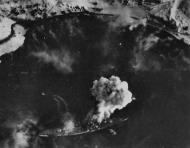
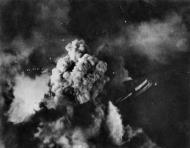
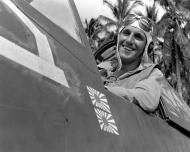

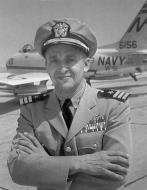
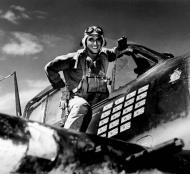
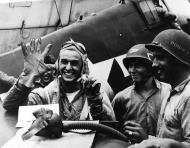
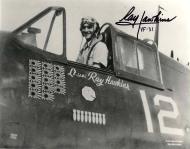
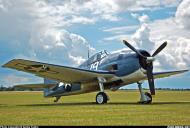
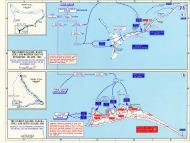
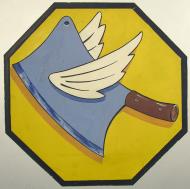
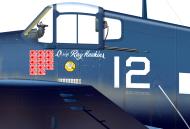
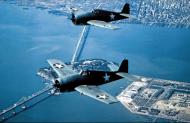

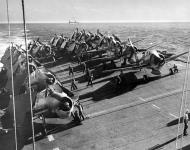
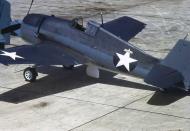

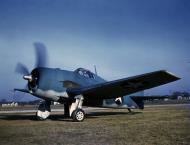
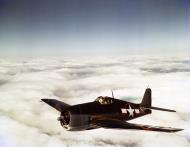
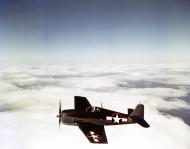



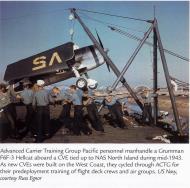
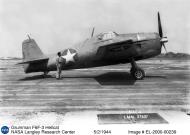
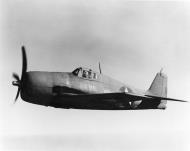
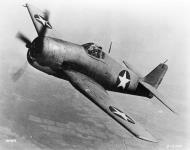
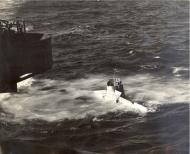
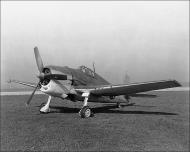
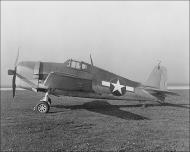

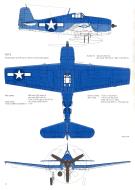
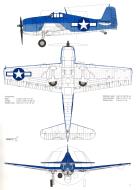
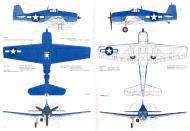
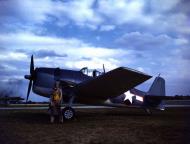
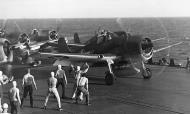
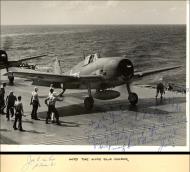
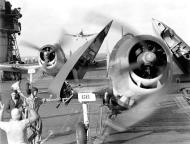
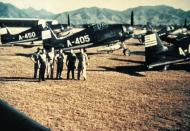
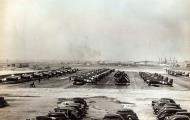
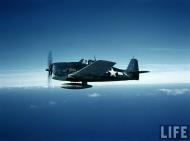
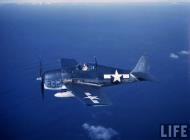
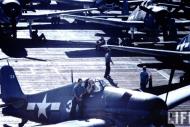
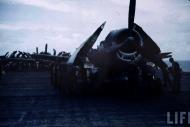
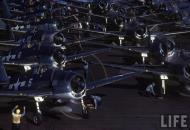
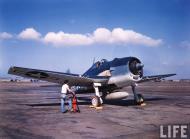
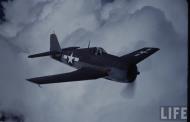
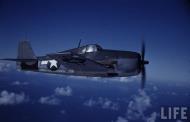




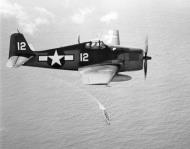
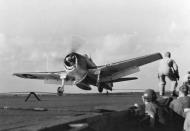
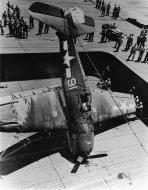
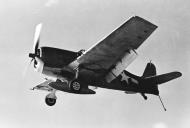
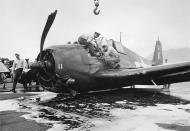
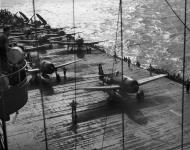
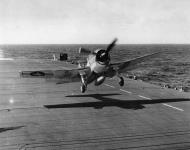
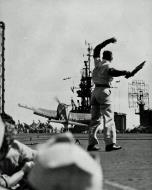
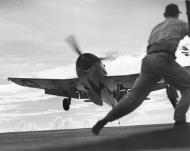
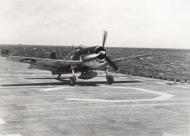
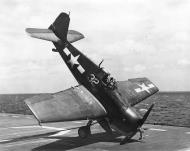
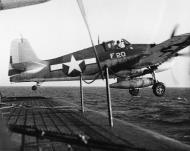
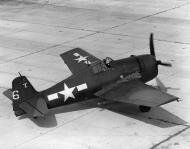
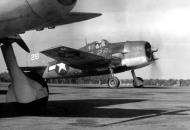
-1st-Jan-1944-ASC1.jpg)
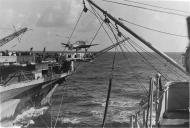
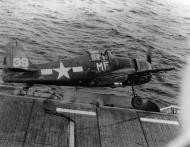
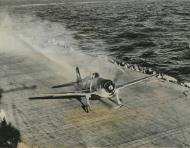
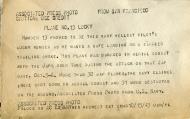
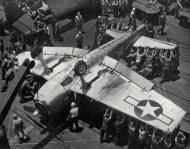
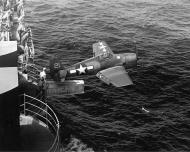
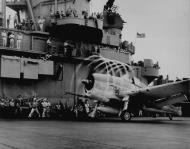
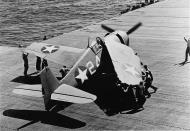

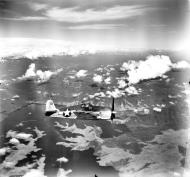
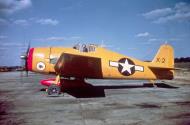
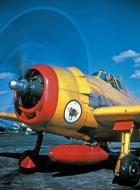

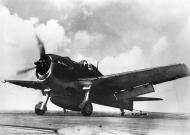
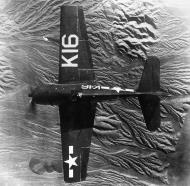


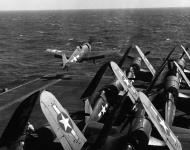
-1st-Jan-1944-01.jpg)

